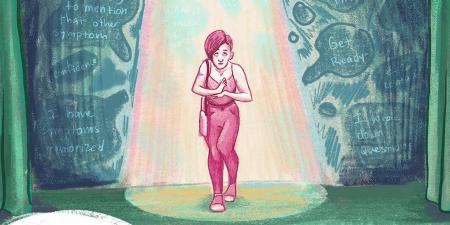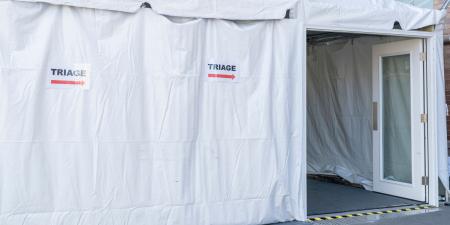Abstract
Many clinicians, including those who work in government, experience potential clashes between their professional responsibilities and personal interests that can create conflicts of interest (COIs). Some clinicians might assert that their personal stakes do not influence their professional actions, but data suggest otherwise. This commentary on a case suggests that COIs must be acknowledged with sincerity and managed such that they are eliminated or, at least, credibly mitigated. Moreover, policies and procedures that guide responses to clinicians’ COIs must be in place before clinicians assume roles in government. Without external accountability and respect for the limits of self-regulation, clinicians’ capacity to reliably promote the public interest without bias could be compromised.
Case
Suppose Dr M is a renowned endocrinologist with a long, distinguished record of national clinical and research service and the chair of the National Clinical Care Commission (NCCC), a committee charged with helping review improvements to US Department of Health and Human Services (HHS) diabetes-related care programs. Dr M also consults and serves on speaker panels for companies developing diabetes interventions. Frequently for international conference presentations, Dr M receives honoraria and travel expenses (ie, transportation, meals, accommodations, document-processing fees) from diabetes therapeutics industry sponsors. Most recently, for example, Dr M spoke about the efficacy and safety profile of a drug that only recently received approval from the US Food and Drug Administration. Company A researched and developed this drug using federal funds. Medicare and Medicaid also cover several million US patients’ prescriptions for this drug, so conferences like this one are also often attended by clinician members of watchdog organizations and advocacy groups, such as Public Citizen.
Public Citizen recently issued a press release describing Dr M’s blatant conflicts of interest (COIs) and misappropriation of federal funds for personal gain due to Dr M’s acceptance of honoraria and travel expense reimbursement from Company A. Public Citizen urged HHS to take action.
Dr M subsequently receives a letter from HHS outlining its concern with Dr M’s acceptance of payment from Company A. HHS stated its intent to investigate and take action.
Dr M offers to return all monies received from Company A and issues a rebuttal to the complaint and a press release, saying: “First, I spoke only as a physician and scientist; I did not speak as a representative of the US NCCC. Second, my remarks did not constitute an endorsement of Company A’s drug. Third, I disclosed my relationship with Company A at the conference. Finally, the remuneration I received from Company A is insufficient to constitute a conflict of interest so substantial as to warrant such a complaint.”
HHS considers how these explanations should inform a decision on whether to take action against Dr M.
Commentary
Many clinicians, including those who work in government, face COIs—potential sources of bias arising from the conflict between their professional responsibilities and personal self-interest.1,2 In this fictional case, the doctor has a clear COI: Dr M received (and frequently receives) honoraria from companies whose products Dr M opines on. Dr M also serves as the chair of the NCCC, a committee that advises the government on patient care. It would be almost impossible for the audience to view Dr M’s public remarks as purely Dr M’s opinion as a physician separately from their role as chair of the NCCC.
Those who accept COIs often believe, and sometimes explicitly assert, that their personal stakes do not influence their professional actions.3 Although the presence of a COI does not necessarily imply that advice is biased,4 research has repeatedly demonstrated that COIs often operate without our awareness and against our best intentions, compromising our judgment. The presence of such conflicts in medicine, regardless of whether judgments are influenced or not, also jeopardizes public trust.5 In this case, the reputation of the NCCC is at stake. What can the US government do to regulate clinician-industry relationships for clinicians who advise the government on health care programs? Before answering this question, I will first discuss the influence of COIs on physician decision making and the limits of COI disclosure policies.
Insufficiency of Disclosure
Clinicians who think they are not biased by their COIs have an inaccurate mental model of how such conflicts work. Although some clinicians who have COIs might make a deliberate choice to act unethically and place their financial interests over their professional responsibilities, most clinicians with COIs do not behave in such an explicitly corrupt way.2 Rather, they assume they can self-regulate and ward off any unwanted influence.2 Consequently, they believe they can speak about, recommend, or advocate for particular treatments without bias.
In reality, COIs exert influence unintentionally, as evidenced by social science research. Clinicians, like all decision makers, are influenced by COIs even when they try to be objective and impartial.6,7,8 For example, physicians typically report that their patients’ health and well-being come first and that they can remain independent, despite receiving incentives from industry.2,9 However, studies have shown that physicians who receive payments from industry prescribe their sponsors’ drugs and request that specific drugs be added to a hospital formulary more often than physicians who are not paid by industry.10,11
Dr M’s public appeal included the fact that Dr M disclosed a financial interest in Company A at the conference. While such transparency is important from an ethical viewpoint, the clinician-industry relationship is problematic regardless of whether Dr M disclosed it or not. Simply put, disclosure does not solve the concern of the biasing influence of COIs, and, as mentioned, it can compromise public trust in medicine.2,12 To be clear, disclosure is not intended to “manage” COIs but to identify such conflicts so that institutions can determine what steps—such as the elimination of the COI—are needed to reduce the risk of compromised judgments or a loss in public trust.5 The Physician Payments Sunshine Act13 requires any transfers of values of $11.64 or more made to physicians, teaching hospitals, and advanced practice clinicians—with the total not exceeding $116.35—to be disclosed on a public website.14 A serious limitation of the act, however, is that the obligation to disclose only falls on the donor and not on the recipient (although the affected clinicians and teaching hospitals now have the opportunity to review reported disclosures and correct any errors).
As will be discussed in what follows, disclosing COIs can in itself lead to unintended consequences for both the recipients of disclosure and the professionals, including clinicians, who are disclosing the conflict.15,16,17 Thus, governmental medical institutions and commissions, such as the NCCC, need to carefully determine how to eliminate the presence of such conflicts among their members.
Consequences of COI Disclosure
Recipients’ reaction. Disclosure of COIs often poses difficulties for recipients. Unsure of how to react to disclosure, they frequently ignore it,18,19,20 or they either trust the physician more (associating such relationships with expertise)21,22,23 or trust the physician less (becoming skeptical of the physician’s integrity or benevolence), even when the physician’s advice is of demonstrably high quality.24 Despite sometimes trusting the physician’s advice less, recipients may also feel increased pressure to comply with it to avoid signaling distrust and insinuating that the physician could be biased by their conflict.25 This psychological process—known as insinuation anxiety—can lead to greater compliance with advice with disclosure than without disclosure.25
High confidence in one’s ability to consciously control any biasing influence represents a shallow understanding of the concept of professionalism.
Clinician bias. COI disclosure can also affect the behavior of clinicians themselves. Disclosing the conflict can increase or decrease the extent to which advice is biased, depending on the context,26 experience of the advisor,27 and whether sanctions are available for penalizing biased advice.28 In previous research, I found that salient COI disclosures can decrease bias in advice of professionals, such as physicians, by reminding them to place their patients first.26 However, as I noted, “eliminating or reducing COIs … [is] likely to have a much larger effect on improving advice quality than policies such as disclosure…. Policy makers must be cautious to avoid any indirect harm that disclosure could cause if it displaces more effective measures against conflicts of interest.”26
The Professionalism Paradox
Many professionals, including physicians, take offense at the notion that they might be influenced by financial incentives.3 Their reaction reveals, yet again, the robust belief that bias resulting from COIs is within our conscious control. For example, when testifying before the US Securities and Exchange Commission in 2000, high-ranking executives of top accounting firms, including Arthur Andersen, cited “professionalism” as a reason they and their employees could remain unbiased and objective in the presence of COIs.29 Just a year later, Andersen was implicated in the Enron scandal and subsequently surrendered its accounting licenses.
Although a strong sense of professionalism and integrity can help protect against intentional corruption, it does not mitigate unintentional and implicit bias arising from COIs. In fact, belief in one’s ability to remain impartial and professional could even make matters worse.3 Similarly, assertions of one’s unbiased reasoning can increase bias, as “saying is believing.”30 Moreover, studies have shown that advocating for a past decision can strengthen one’s belief that it was the right decision, even if it was not.30,31
High confidence in one’s ability to consciously control any biasing influence represents a shallow understanding of the concept of professionalism.3 Those with such a strong but shallow sense of professionalism may more readily accept COIs and believe they need to work less hard than others to correct for the potential influence of a COI, ironically leading to greater acceptance of COIs and more bias.3 Instead, physicians need to cultivate a deep understanding of the concept of professionalism. More than simply confidence in one’s ability to self-regulate unwanted influence and complying with the letter of law and hospital policies, deep professionalism entails the understanding that because we all have limits to our self-regulatory capacities, it is best to avoid COIs altogether.3 Physicians with deep professionalism will also embrace continued ethical training to embed this understanding. As I have written elsewhere:
[I]f a hospital policy bans pharmaceutical representatives from interacting with physicians in their hospitals and curtails their free lunches, physicians who understand the deeper concept of professionalism will also reject walking across the street from the hospital to indulge in the free lunches the pharmaceutical company now sets up in hotel conference rooms. Even if a policy does not regulate physicians’ behavior outside of the hospital, those with deep professionalism will understand and internalize the principles and values of self-regulation as well as nurture the values repeatedly with an active practice.3
Gifts
Clinicians, such as Dr M, often make the mistake of focusing on the size of the COI, assuming that small gifts are insufficient to affect their decisions. This notion is reinforced by policies that set arbitrary amounts under which gifts or honoraria are acceptable. For example, the American Medical Association (AMA) and at least 5 states and the District of Columbia have set guidelines for what they deem acceptable payment amounts for physicians.32 A 2013 revision to the AMA Code of Medical Ethics stated that gifts “in the general range of $100 are permissible,” but the empirical basis for this guideline is lacking.33 By comparison, the Kaiser Permanente defines “significant financial interest” for clinical researchers as remuneration exceeding $5000 in 12 months.34
Accepting a gift incurs a debt and evokes the norm of reciprocity—the obligation to help those who have helped you. In many cultures, accepting a gift without reciprocation is socially unacceptable.9 Anthropologist Marcel Mauss has documented formalized gift-giving rituals of leaders negotiating conflict settlements.35 Michael Oldani, an anthropologist and former pharmaceutical representative, noted that “the importance of developing loyalty through gifting cannot be overstated”36 and that “the essence of pharmaceutical gifting” is “bribes that aren’t considered bribes.”37
While the magnitude of a COI may affect how people view the conflict (for example, people may view a clinician’s acceptance of a personal gift of large value as less acceptable than smaller gifts), even very small gifts (eg, lunch, stationary) are known to affect physician decision making.38 In fact, small gifts may be even more pernicious than large ones, as they may go almost unnoticed by recipients.3 As I have previously noted: “Large gifts are likely to create a conscious sense of indebtedness to the gift-giver and may activate attempts to avoid them or to reflect on their possible influence and correct for it. In the case of small gifts, however, people often hold the belief that they are too small to matter, allowing them to bypass scrutiny.”3
Public Accountability
Many policies and regulations that have been proposed to mitigate the negative effects of COIs have had limited success.16 Attempts to reduce bias through education can increase people’s understanding of COIs. Such training, however, might only convince people that others are susceptible to self-serving biases but that they themselves are immune.39 This belief again highlights our resistance to accepting that biases can operate subconsciously.
Returning to the case, should Dr M be “punished” for the COIs with a fine or penalty or even banned from speaking? Sanctions or penalties for bias are problematic, as they can encourage people to view decisions in terms of a cost-benefit analysis rather than as an ethical issue.40 Also, it is often impossible to determine which advice is best and least biased, given the presence of multiple treatment options41; thus, accusations of bias and influence will be hard to prove and the resulting sanctions or fines difficult to implement.
The major issue, in this case, is Dr M’s financial relationships with industry and their influence on Dr M’s role in the NCCC. Such relationships undermine both Dr M’s professional reputation and that of the NCCC, just as they would undermine the reputation of any professional organization accepting a corporate donation.42 They also compromise Dr M’s capacity to independently and objectively issue recommendations to the government on patient care. As such, Dr M should step down from serving on the commission.
As mentioned, simply disclosing these relationships is insufficient. The only effective way to manage COIs is through sincere attempts to eliminate them. What’s promising is that the disclosure of the absence of COIs could justifiably increase public trust.43 The US government needs to put in place clear procedures and policies regarding the elimination or mitigation of any COIs before physicians assume public roles, such as serving on or advising government or patient advocacy groups. For example, if the NCCC had a clear policy of “no financial relationships with industry” available from the start, there would have been no confusion for either party regarding whether Dr M could serve on the commission. Clinicians with public roles must be held to higher standards than other physicians and receive continuing education on the concept of deep professionalism.3 It is commendable that Dr M returned all monies received from Company A, but such conflicts also need to be avoided in the first place. Even if physicians believe they will not succumb to any biasing influence from COIs (at least, not intentionally), they nevertheless need to be held accountable for them.
References
- Carson TL. Conflicts of interest. J Bus Ethics. 1994;13(5):387-404.
- Sah S. Conflicts of interest and your physician: psychological processes that cause unexpected changes in behavior. J Law Med Ethics. 2012;40(3):482-487.
- Sah S. The professionalism paradox: professionalism increases vulnerability to conflicts of interest. Acad Manage Perspect. 2022;36(3):896-918.
-
Lo B, Ott C. What is the enemy in CME, conflicts of interest or bias? JAMA. 2013;310(10):1019-1020.
-
Lo B, Field JM, eds; Institute of Medicine. Conflict of Interest in Medical Research, Education, and Practice. National Academies Press; 2009.
-
Wazana A. Physicians and the pharmaceutical industry: is a gift ever just a gift? JAMA. 2000;283(3):373-380.
- Chimonas SC, Brennan TA, Rothman DJ. Physicians and drug representatives: exploring the dynamics of the relationship. J Gen Intern Med. 2007;22(2):184-190.
-
Sah S. Conflicts of interest and disclosure. Royal Commission Into Misconduct in the Banking, Superannuation and Financial Services Industry; 2018. Accessed July 22, 2022. https://sunitasah.com/media/pdfs/Sah-2018-Conflicts-of-interest-and-disclosure-Banking-Royal-Commission.pdf
- Sah S, Fugh-Berman A. Physicians under the influence: social psychology and industry marketing strategies. J Law Med Ethics. 2013;41(3):665-672.
- Chren MM, Landefeld CS. Physicians’ behavior and their interactions with drug companies. JAMA. 1994;271(9):684-689.
- Goldfinger SE. A matter of influence. N Engl J Med. 1987;316(22):1408-1409.
- Marks JH. Beyond disclosure: developing law and policy to tackle corporate influence. Am J Law Med. 2020;46(2-3):275-296.
-
Patient Protection and Affordable Care Act, Pub L No. 111-148,124 Stat 119 (2010).
-
Data collection. Centers for Medicare and Medicaid Services. Updated September 27, 2022. Accessed October 21, 2022. https://www.cms.gov/OpenPayments/Program-Participants/Reporting-Entities/Data-Collection
- Loewenstein G, Sah S, Cain DM. The unintended consequences of conflict of interest disclosure. JAMA. 2012;307(7):669-670.
- Sah S. Policy solutions to conflicts of interest: the value of professional norms. Behav Public Policy. 2017;1(2):177-189.
- Sah S, Loewenstein G, Cain DM. The burden of disclosure: increased compliance with distrusted advice. J Pers Soc Psychol. 2013;104(2):289-304.
- Hampson LA, Agrawal M, Joffe S, Gross CP, Verter J, Emanuel EJ. Patients’ views on financial conflicts of interest in cancer research trials. N Engl J Med. 2006;355(22):2330-2337.
- Pearson SD, Kleinman K, Rusinak D, Levinson W. A trial of disclosing physicians’ financial incentives to patients. Arch Intern Med. 2006;166(6):623-628.
-
Rose S, Sah S, Raed D, et al. Patient responses to physician disclosures of industry conflicts of interest: a randomized field experiment. Organ Behav Hum Decis Process. 2021;166:27-38.
- Sah S, Fagerlin A, Ubel PA. Effect of physician disclosure of specialty bias on patient trust and treatment choice. Proc Natl Acad Sci U S A. 2016;113(27):7465-7469.
- Okike K, Kocher MS, Torpey JL, Nwachukwu BU, Mehlman CT, Bhandari M. Level of evidence and conflict of interest disclosure associated with higher citation rates in orthopedics. J Clin Epidemiol. 2011;64(3):331-338.
-
Sah S, Malaviya P, Thompson D. Conflict of interest disclosure as an expertise cue: differential effects due to automatic versus deliberative processing. Organ Behav Hum Decis Process. 2018;147:127-146.
-
Sah S, Feiler D. Conflict of interest disclosure with high-quality advice: the disclosure penalty and the altruistic signal. Psychol Public Policy Law. 2020;26(1):88.
- Sah S, Loewenstein G, Cain DM. Insinuation anxiety: concern that advice rejection will signal distrust after conflict of interest disclosures. Pers Soc Psychol Bull. 2019;45(7):1099-1112.
-
Sah S. Conflict of interest disclosure as a reminder of professional norms: clients first! Organ Behav Hum Decis Process. 2019;154:62-79.
-
Koch C, Schmidt C. Disclosing conflicts of interest—do experience and reputation matter? Account Organ Soc. 2010;35(1):95-107.
- Church BK, Kuang X. Conflicts of interest, disclosure, and (costly) sanctions: experimental evidence. J Leg Stud. 2009;38(2):505-532.
-
Hearing on auditor independence. US Securities and Exchange Commission. July 26, 2000. Accessed September 16, 2016. https://www.sec.gov/rules/extra/audmin.htm
- Higgins ET, Rholes WS. “Saying is believing”: effects of message modification on memory and liking for the person described. J Exp Soc Psychol. 1978;14(4):363-378.
- Festinger L, Carlsmith JM. Cognitive consequences of forced compliance. J Abnorm Psychol. 1959;58(2):203-210.
- Hwong AR, Sah S, Lehmann L. The effects of public disclosure of industry payments to physicians on patient trust: a randomized experiment. J Gen Intern Med. 2017;32(11):1186-1192.
-
Reference Committee. Amendment to E-8.061, “Gifts to physicians from industry.” In: Greene HR. Reports of the Council on Ethical and Judicial Affairs. American Medical Association; 2013:191-201. Accessed October 6, 2022. https://www.ama-assn.org/sites/ama-assn.org/files/corp/media-browser/public/hod/a13-ceja-reports_0.pdf
-
Kaiser Permanente policy on conflicts of interest in research. Kaiser Permanente Washington Health Research; 2012. Accessed April 14, 2022. https://www.kpwashingtonresearch.org/application/files/4815/5432/4781/KP_policy_on_conflicts_of_interest_in_research.pdf
-
Mauss M. The Gift: The Form and Reason for Exchange in Archaic Societies. Routledge; 2006.
- Oldani MJ. Thick prescriptions: toward an interpretation of pharmaceutical sales practices. Med Anthropol Q. 2004;18(3):325-356.
-
Oldani M. Quoted in: Elliott C. The drug pushers. Atlantic. April 2006. Accessed October 6, 2022. https://www.theatlantic.com/magazine/archive/2006/04/the-drug-pushers/304714/
- Steinman MA, Shlipak MG, McPhee SJ. Of principles and pens: attitudes and practices of medicine housestaff toward pharmaceutical industry promotions. Am J Med. 2001;110(7):551-557.
- Babcock L, Loewenstein G. Explaining bargaining impasse: the role of self-serving biases. J Econ Perspect. 1997;11(1):109-126.
-
Feldman P. Drug companies pony up in illegal marketing cases, but critics wonder if penalties are enough. Times. May 10, 2016. Accessed September 19, 2016. https://www.timesonline.com/story/lifestyle/health-fitness/2016/05/10/drug-companies-pony-up-in/18565965007/
- Sah S. Investigations before examinations: this is how we practice medicine here. JAMA Intern Med. 2015;175(3):342-343.
- Brody H. Professional medical organizations and commercial conflicts of interest: ethical issues. Ann Fam Med. 2010;8(4):354-358.
- Sah S, Loewenstein G. Nothing to declare: mandatory and voluntary disclosure leads advisors to avoid conflicts of interest. Psychol Sci. 2014;25(2):575-584.



